
Neoagarum fimbriatum
Fringed Sieve Kelp, Fringed Sea Colander Kelp
Specimens Collected: 14 January 2022
Note: this is a subtidal alga; we encountered it washed ashore and as such specimens were collected from two locations for closer observation and review.
Goose Spit, Strait of Georgia, BC.
Tide: 13.2 feet at 09:30 am PST (measured at Comox Tidal Station), and
Kye Bay, Strait of Georgia, BC.
Tide: 13.2 feet at 11:00 am PST (measured at Little River Tidal Station)
Conditions: Low overcast, southerly wind 15 to 25 km/h, sea light chop, humidity 96%, 7˚C.
Interactions and reporting started: 15 January 2022
Moon: Waxing Gibbous (95.8%, day 13); Previous Phase, First Quarter, 9 Jan 2022 at 10:13am PST: Next Phase, Full Moon, 17 Jan 2022 at 3:51pm PST.
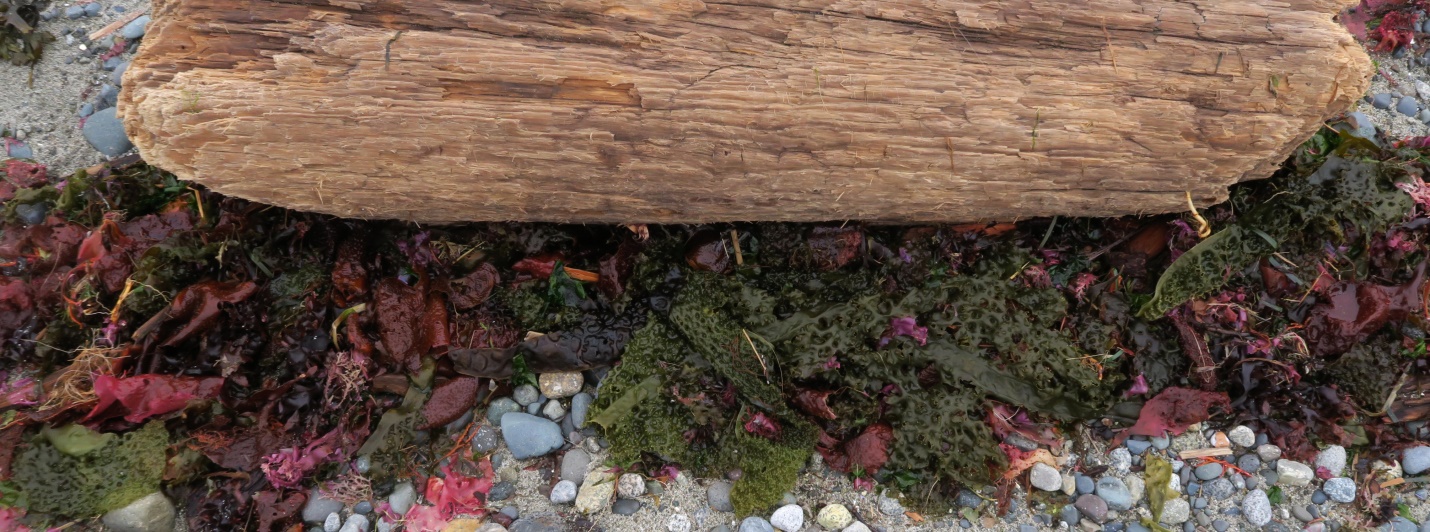
Figure 1: The mix of seaweed as it looked in the ‘wrack’ or ‘drift’ at Little River Beach, Strait of Georgia, BC, Canada. Most of the Neoagarum fimbriatum pieces are quite aged and have ‘bleached’ from brown to various shades of green. January 14, 2022. Photo ID 27173 ©Seaweedwhisperings.com
Person 1:
Picky about name – hyphen? [Should it be fringe hyphen kelp, or two separate words?]
Ray [Batoidea] – flat with wings.
Holes look like spots on whale shark.
Tattered edge along rib like tail of stingray.
Predatory, not pretty.
I feel like wandering amongst the four specimens, rather than focusing on detail.
Rib is strong, holding otherwise fragile thallus together.
Rather tenuous hold on substrate.
Outwardly impressive with the size of blade but “full of holes” – fragile ego, but can still hold on and persevere.
Decorated – lots of adornments – multi-branched holdfast; fanciful fimbriae; showy belt (central rib); puckers; holes; papillae; ruffles on edges. Very showy seaweed.
I notice that I am particular about my punctuation with these notes – wanted the semi-colon use above.
I seem to be fixated on its appearance and not readily able to see beneath the façade.
Perhaps flirty, promiscuous with a rather superficial expression of sexuality. I see it as feminine, either heterosexual female, or a gay man.
Exaggerated external expression of femininity in a man – effeminate.
Wonder if it has strong ideals (strong midrib) but hides them to conform within its society.
Unsatisfied with its role but feels trapped in its image.
My interactions with this seaweed abruptly ended, as though I became totally bored with its lack of depth.
Thinking about its name, Fringed Sieve Kelp – common name is simply a good description of its appearance, thus matching the flamboyance and superficiality. Scientific name is boring.
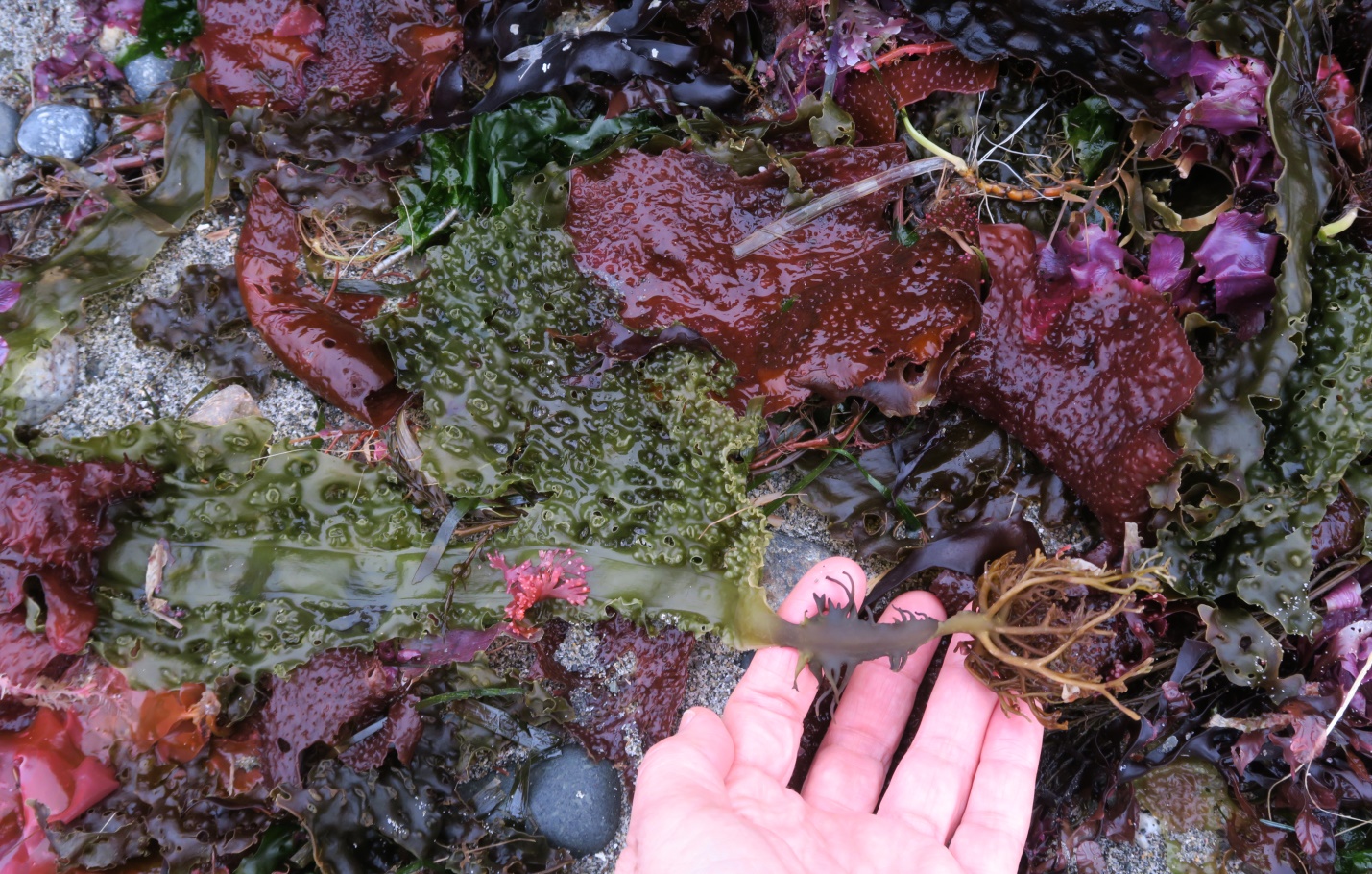
Figure 2: Mixed in with other seaweeds, featured here is one of the countless pieces of Neoagarum fimbriatum that were washed ashore this day. This one has various stages of color bleaching; the haptera of its holdfast are golden brown, its stipe and fimbriae (held in above my fingers) are darker chocolate brown and its midrib and blade are variations of shades of green. Little River Beach, Strait of Georgia, BC, Canada. January 14, 2022. Photo ID 27174 ©Seaweedwhisperings.com
Person 2:
Yesterday, at every beach we explored you were present. Washed up in the drift/wrack. Sooooo many pieces of Neoagarum fimbriatum. Tossed up with other macroalgae, too, the prominent red being Chondracanthus exasperatus. There was a mix of colors – as each seaweed faded from fresh to bleached, that was really quite amazingly beautiful.
Mix of colors – like an artist’s palette. Golden bronze, caramel brown, chocolate brown, rich magenta, neon orange, glowing burgundy, rosy pink, and various shades of green ranging from army, hunter, emerald, chartreuse and sage. Not a necessarily a restful combination, no, and it’s an astonishingly diverse one.
This seaweed is one I’ve only seen washed ashore; I believe its habitat is subtidal and so it is only in this manner that I can encounter it.
And to identify this kelp is easy – it has everything! A branched haptera holdfast, a stipe that is flattened but also is adorned with irregular projections called fimbriae, a broad and distinctive midrib, a very broad blade that is bullate and punctured irregularly with holes, and margins of the blade that are ruffled and edged with multiform offshoots, too. All this has to be present, or it’s not Neoagarum!
It’s as if this seaweed wanted to try everything out, use any growth form that might aid it, or feel interesting, or simply be worth a try to explore.
AND it has not abandoned any of these morphology traits it has sampled; Neoagarum fimbriatum has retained them all.
Compared to other close relatives, Neoagarum has the biggest mix of features.
Does this take effort to keep all in one?
Or does this provide variety to one who is quickly bored and enjoys delving into something new?
The resulting “look”, however, is not svelte or elegant like some other kelps. No, it’s almost clownish, certainly a bit messy, and at the end of the blade most distant from the stipe, extremely tattered, torn up and showing its age/experience.
Feel; the blade feels rough as I run my fingers lightly over it, somewhat like the outermost edges of a coarse vegetable grater. This is due to the bullae and the holes that punctuate the blade. The holes are as if punched through from one side to the other and there is a ‘rim’ to the edges of each hole.
And the direction these holes are punched through is from both sides of the broad blade.
“Both sides” seems to be a notable concept for this kelp.
Also the farther from the holdfast you go, the larger these holes become.
The farther from the holdfast the more torn and tattered the blade itself becomes entirely, too.
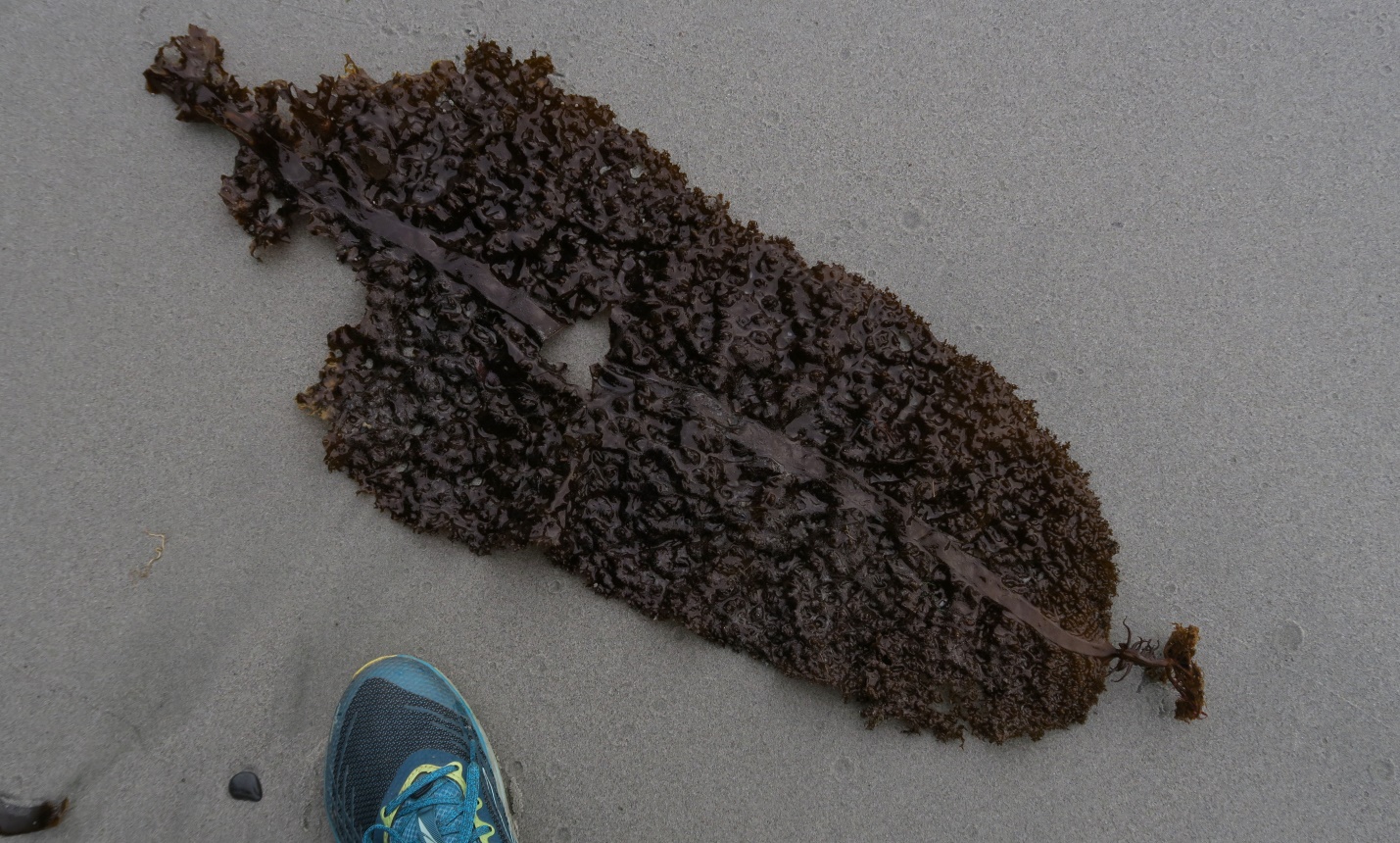
Figure 3: Neoagarum fimbriatum washed ashore, (with my foot in the photo to help give size estimate), the tattered tip of the thallus is typical for this species; Gonzales Bay, Juan de Fuca Strait, BC, Canada. January 4, 2021. Photo ID 27175 ©Seaweedwhisperings.com
At the center of the blade, arising directly from the stipe, is the broad mid rib. It is smooth, flat, and thick. It’s also very tough (certainly in comparison to the rest of the blade). One piece I found had a section of full blade for about 40 cm, then a section with some blade on either side of the midrib for another 50cm or so, and then a section of the midrib which was again about 40 cm long with almost no trace of the blade left on either side.
The midrib endures; the holey, bullate, frilly edged blade – definitely does not endure so well.
And what about the fimbriae on the stipe, all those projections. What function do they serve? It’s not likely to be photosynthesis…, could possibly be reproductive…, maybe it’s something much less practical, but whatever its function it’s very distinctive and individualizing, having all these fimbriae along the stipe.
The holdfast is many branched and seems that seem to want to spread out and grasp the substrate as well as they can (the base of the hold fast often clearly shows the ‘topography’ of the substrate it was previously affixed to). But the holdfast, as seen in all these washed ashore specimens, obviously fails. Does the blade get simply too big? Then if you grow in intertidal areas that are exposed, you can easily be pulled away by the high winds of late fall and early winter.
I believe many of these individuals grow sub tidally, so then what is it that dislodges them? Possibly whatever Neoagarum fimbriatum attaches itself to (the substrate, sunken wood, other algae) is otherwise dislodged and then all is vulnerable to surf action? I don’t know. My understanding is that deeper waters are also ‘still waters’ so I do wonder what dislodges you.
I imagine that you must create quite the ‘close to the bottom’ forest canopy, with extensive groupings of you; otherwise it’s hard to understand how so very many of you can be washed ashore now.
I can see that Person 1 is finished with his notes and we have to vacate this room soon (we were out of town and staying in an inn) so I will ‘pause’ my interactions with Neoagarum now.
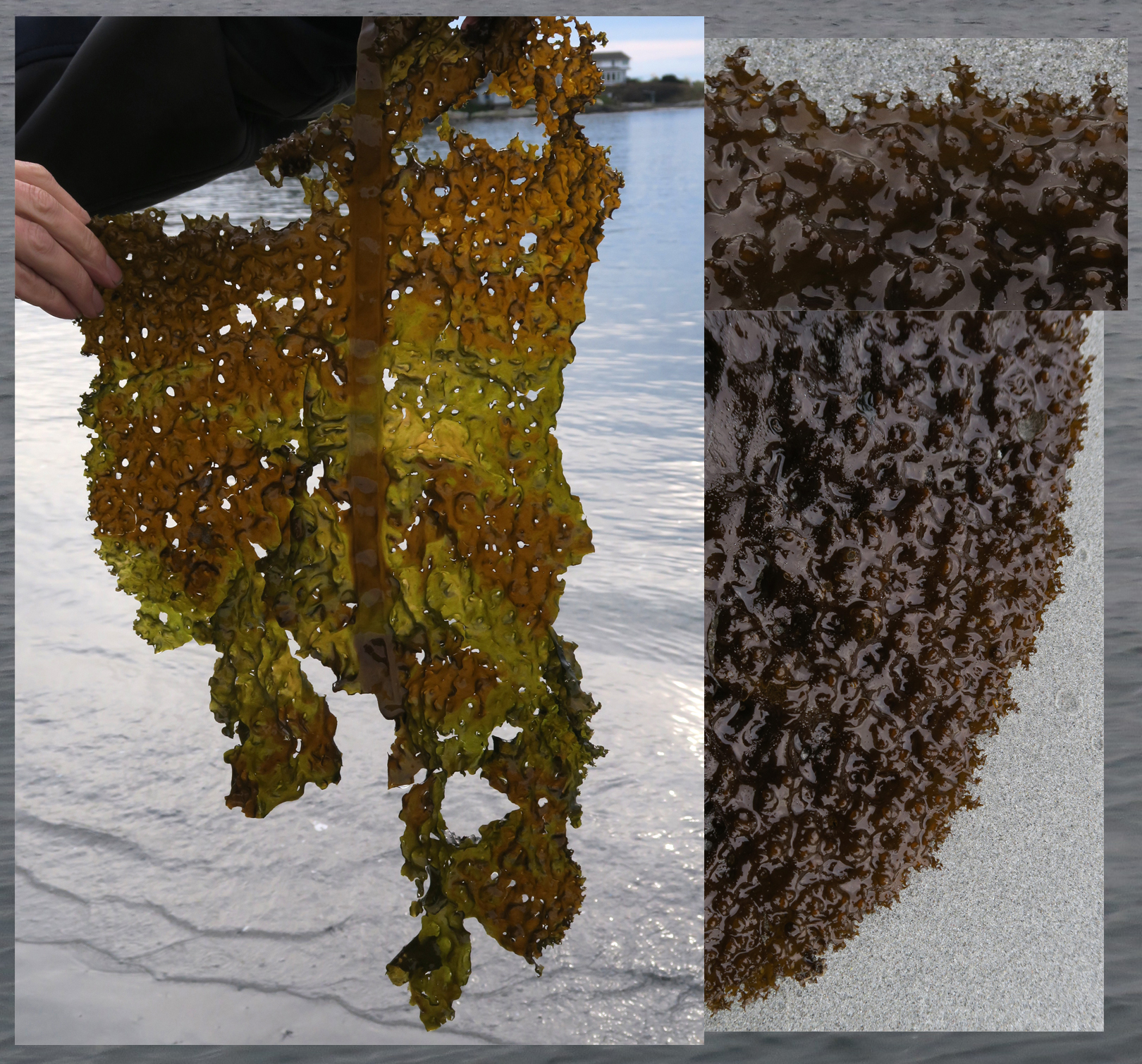
Figure 4 (Above left): Holes, frills, bullae, rips and tears along stronger midrib, and variations of ‘bleached’ color hues are all depicted here with this Neoagarum fimbriatum specimen found washed ashore at Gonzales Bay, Juan de Fuca Strait, BC, Canada. December 3, 2020. Photo ID 27176 ©Seaweedwhisperings.com
Figure 5 (Above right): The “fringe” edge of “Fringed Sieve Kelp” is depicted well here. Gonzales Bay. January 4, 2021. Photo ID 27177 ©Seaweedwhisperings.com
Person 2’s additional notes:
With this seaweed I collected 4 samples for us to interact with, not simply 1 or 2. There were admittedly many, many specimens on the beach, but it seemed like ‘more was better’ for this seaweed.
I had not finished my interactions when we needed to pack up and leave our motel room, so I did as I’ve done on previous occasions with other seaweed species and promised myself I would return to it when the time was right. Three days later I noted that this ‘right’ time had still not arrived. I think this was revealing the aspect to this seaweed’s energy that there are always so many other things to be interested in and that returning to the past takes a dedication or an interest that is not that strong in Neoagarum. That at times, efforts are started but not finished, that it is so easy to move on with whatever is present in the here and now and remain busily engaged there. So the original effort may suffer from being given no more attention or upkeep, rather like the tattered distal ends of this seaweed’s blade. The holes in the blade also suggest that there can be ‘holes’ and gaps in certain endeavors.
In our field notes we did not make note of the:
Weather
Tides
Moon phase
Was this sloppy? Why did we forget this typical procedure of ours?
Person 1: Not all together – like the Neoagarum is, it’s all over the place. It’s not a neat organized package. Person 1 says he felt he “sort of just drifted into the interaction with this seaweed. ”. He said that it was kind of “seeping into me” and therefore didn’t really have an official start, prep or set up time.
Person 2 noted that this seaweed was ‘everywhere’ on the beaches in the drift line and clearly reaching out and willing to connect. So, in effect, the ‘conversation’ had already started, again without a formal set up.
Often it had been Person 1’s task to note the weather conditions and possibly the tides.
Person 2 usually checks the moon phase, but all of this was overlooked with this seaweed. We only realized it a week later when the report was being written up.
This information was not impossible to go back and recover…, but doing so took a bit more effort and by doing it we even found a couple more useful resources. We noted that this is likely an issue for Neoagarum fimbriatum. That they don’t go back and recover very often, there’s too much going on in the present to really fit that in. It can also be a lack of attention to all details.
Person 2, observations another few days later:
I’d had an unusually busy week, with much work coming in, some feedback arriving faster than expected or issues to attend to that were more complicated than usual. Clear time to engage with Neoagarum fimbriatum had not yet been available to me.
Six days following when the initial observations and interaction was started I woke up and Neoagarum fimbriatum was present. I had images/memories of many of the specimens I’ve seen in the past year and a half and especially of the largest and most intact specimen I’d ever found (washed ashore on the sand beach at Gonzales Bay). I dipped into resuming my interactions with Neoagarum again with deeply feeling my response to the “look” of this seaweed – it catches your attention in that it has so much going on…, and when I think of it as a whole it doesn’t really all ‘come together’ or ‘work’ in a way that looks ‘good’. It’s ‘too much’, it’s even ‘out of proportion’, and it seems ‘unnecessarily complex’.
Is it out of proportion? Or is that merely the outsider’s perspective?
Is it unnecessarily complex? Possibly complexities or “variations on a theme” are what this energy loves to embrace.
Is it too much or clownish? Maybe this energy can juggle all those components well and doesn’t really care how it looks while doing so. Perhaps it cares much more about how it feels to be engaged in life in that way; yes, I think that can be so.
When you are really into your explorations, Neoagarum fimbriatum, you do not even think about how you look, you don’t have any care about that whatsoever. Your energy is engaged and flowing and you are totally content. What punctures you then, and what knocks you out of this contentment; it seems this could be if Neoagarum compares or is compared to others, and the comparison shows them up as somehow lacking. The solution, return to engagement in one of your numerous explorations – there you are content.
All those holes…, all those variations on ruffled and frilly edges, all those blisters/bullae, all the variations on the fimbriae…., it seems, Neoagarum, that you jump in enthusiastically “with both feet” and try out many things. Are your interests broad ranging? Can you possibly be a master at any of them?
Perhaps you are judged – for your appearance, possibly labeled a clown, or for your enthusiasm, thought of as a fanatic?
Your strong midrib indicates the kind of perseverance you embody at your core, but it does seem that much of you gets torn away as you age.
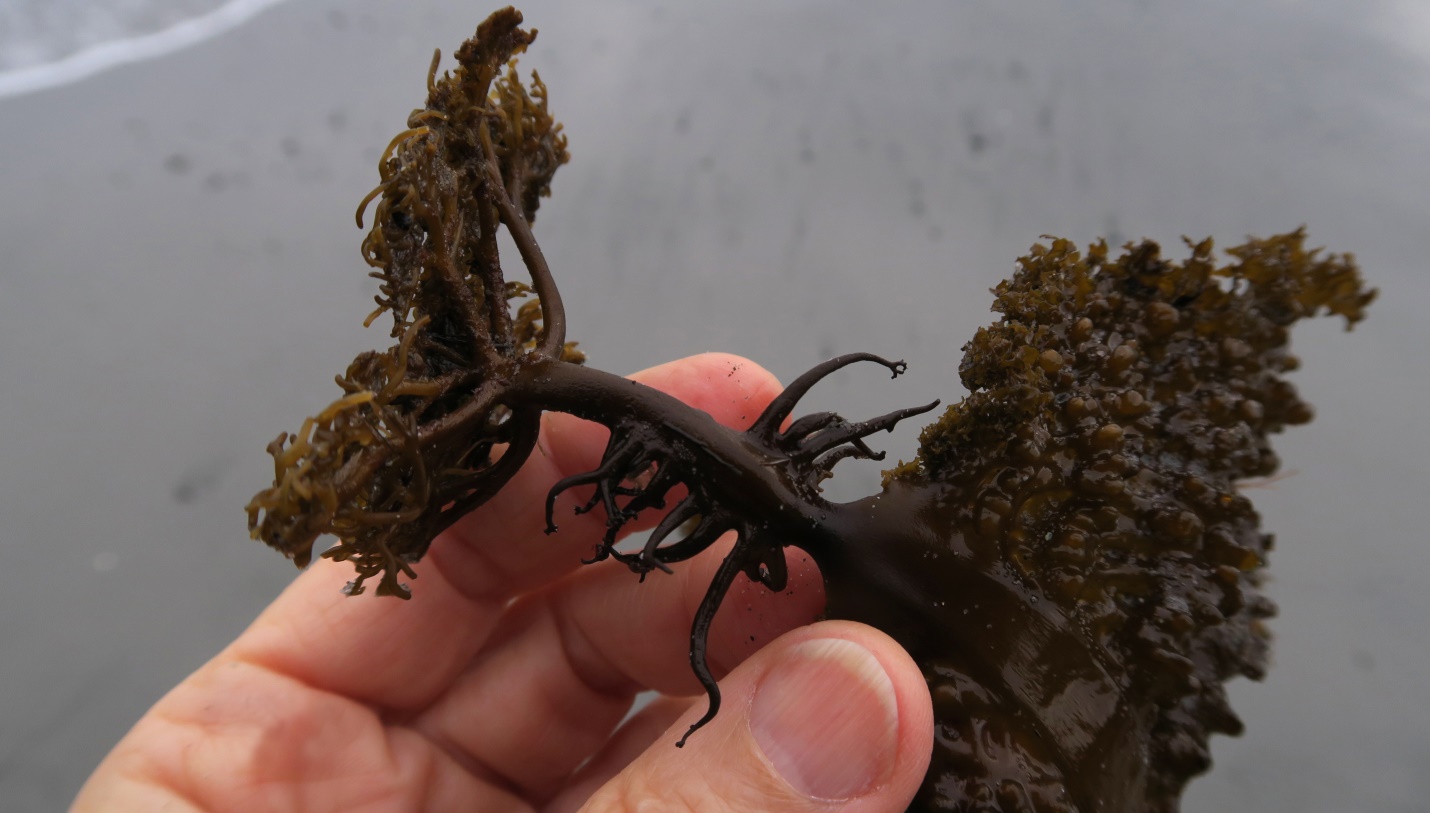
Figure 6: A closer view of the fimbriae – Neoagarum fimbriatum at Gonzales Bay, Juan de Fuca Strait, BC, Canada. January 4, 2021. Photo ID 27178 ©Seaweedwhisperings.com
The completion of this interaction came in “bits and pieces”.
As a whole, for Person 2, it was not possible to have a consistent, one effort ‘look’ at this seaweed. It seems there is an aspect of one who maintains serial efforts on many tasks, and that there is not much empty or available extra time in between these tasks!
Variations, all the variations…, then I thought of the phrase “variations and permeations”. And since spelling has never been my strongest grammatical suit, I thought, do I mean permeations or permutation?
I looked up some definitions.
Permutation: is a way, especially one of several possible variations in which a set or number of things can be ordered or arranged.
This is interesting…, it doesn’t quite have the ‘feel’ I was looking for in the word as Neoagarum is not always so interested in ordering or arranging things.
Then I looked up permeation: the quality or state of being permeated.
Permeable: capable of being permeated; penetrable especially having pores or openings that permit liquids or gasses to pass. Limestone is permeable and a frogs skin, too, to the passage of water. Person 1 said that the energy of this seaweed just was “seeping in” to his awareness – another confirmation for the concept of permeable. This seems to fit the energy of Neoagarum a bit better than permutation does.
I wanted to find some photographs of this seaweed as it lives in situ underwater. I have only found it washed ashore and had no true image of what it looks like in its habitat. It is interesting to see that the big blade lies prostrate on the sea floor, so the holes in the blade must be what allow this position. It becomes quite a ‘kelp habitat’ but only to those creatures who live at or very near the ocean bottom.
When I did a search for such photos I found an article summarizing a study done on Neoagarum fimbriatum in Howe Sound BC, Canada, that was published in 2018.
I then found out about the issue of green urchin over-grazing on this seaweeds population and also the relationship between green urchin populations and the wasting disease that affected the sunflower stars (and other sea stars) in coastal waters all over British Columbia in 2013.
I then found myself wandering down the interesting avenue of looking at sea star identification and what they eat, and so on…
This is notable! In this interaction, it seems it was sooooo easy to go off on tangents…, to find more things to explore, learn about, follow up on….
Like the sunflower star that eats the green urchins that graze on this seaweed – the sunflower star has the most arms of any sea star, it’s the largest sea star in the Pacific Northwest, and its Latin name is Pycnopodia helianthoides, so the Latin root for part of the species name, “helio”, gives us the image of the sun’s rays or sunflowers which have multiple ray flowers pointing in all directions.
Going off or reaching in all directions – I shared this concept with Person 1, and said, “I think then that this energy could be completely…” and before I could finish my sentence, Person 1 completed it with the word, “overwhelming”.
“Overwhelming. OK, how so does this ‘overwhelming’ look…?”
“Massive amounts of data and directions to investigate”, Person 1 said.
“OK, yes, I can see that for the outsider,” and Person 2 added, “but when in balance, this energy that could be ‘overwhelming’ to another, for Neoagarum themselves, is actually completely enveloping in a satisfyingly encompassing way. It is actually wonderful, as in full of wonder, as in, “Wow, what an amazing, fascinating, interconnected, diverse world we live in!”
And Person 1 saw that the opposite of this balance would be obsessive. This concept reminded me of the sea star species, Pycnopodia helianthoides, which controls/preys on the green sea urchin populations who in turn prey on the kelp beds of Neoagarum fimbriatum; this sea star is known as a “voracious and speedy carnivore” and to “eat just about anything in its path”. Prey includes green and red sea urchins, clams, scallops, abalone, snails, barnacles, and occasionally other sea stars. This brings the concept to mind of a “large and voracious appetite”. I think Neoagarum fimbriatum has this energy, a very large appetite that is rarely sated. This indeed could look like obsessive, too, couldn’t it? It also brings in the “predatory” concept that Person 1 noted in his early observations. Is there something here, the predator/prey relationship such that the whole energy of the interconnected players is present in Neoagarum?
When adding photographs to this document I wanted to check the name of one of the beaches where we found specimens of this seaweed on the day we decided to collect a few washed ashore algae and to commence doing our observations. This was another example, like the weather and moon information, where we went ‘back over’ and checked with the gazetteer. And, indeed, we found out new to us information, that the beach we were thinking of does, in fact, have an officially recorded name (which is surprisingly rare for beaches in our area, bays are named, harbors, too, but few beaches). Just as it was with the phase of the moon data, we found a whole other resource for accessing this data.
So, if we go back over to fill in gaps/holes…, we learn more. So there is in this seaweed’s energy at times both the need to “go back over” as there are ‘holes’ in the report (for certain!), holes in their understanding, and then when we do that, we actually learn more than if we had just done it in the first place with our currently existing knowledge/habits tidily in place.
Interruptions, interrupting, interrupted…!
In working on this write up, and indeed in observing and collecting this seaweed for our interaction, there were many interruptions, pauses where other things had to be attended to and so on. In my own write up work I found my time, which should have been clear and free for me to focus, was interrupted numerous times – this was notably extreme. I in turn interrupted Person 1 numerous times to consult/question him on various points as I wrote up our report. I could come back to my work where I had left it before the interruption, but this took dedication and focused concentration – without that I found that it was entirely likely that I could have interestedly and contentedly gone off along some other task/tangent for minutes, hours, days, lifetimes….?
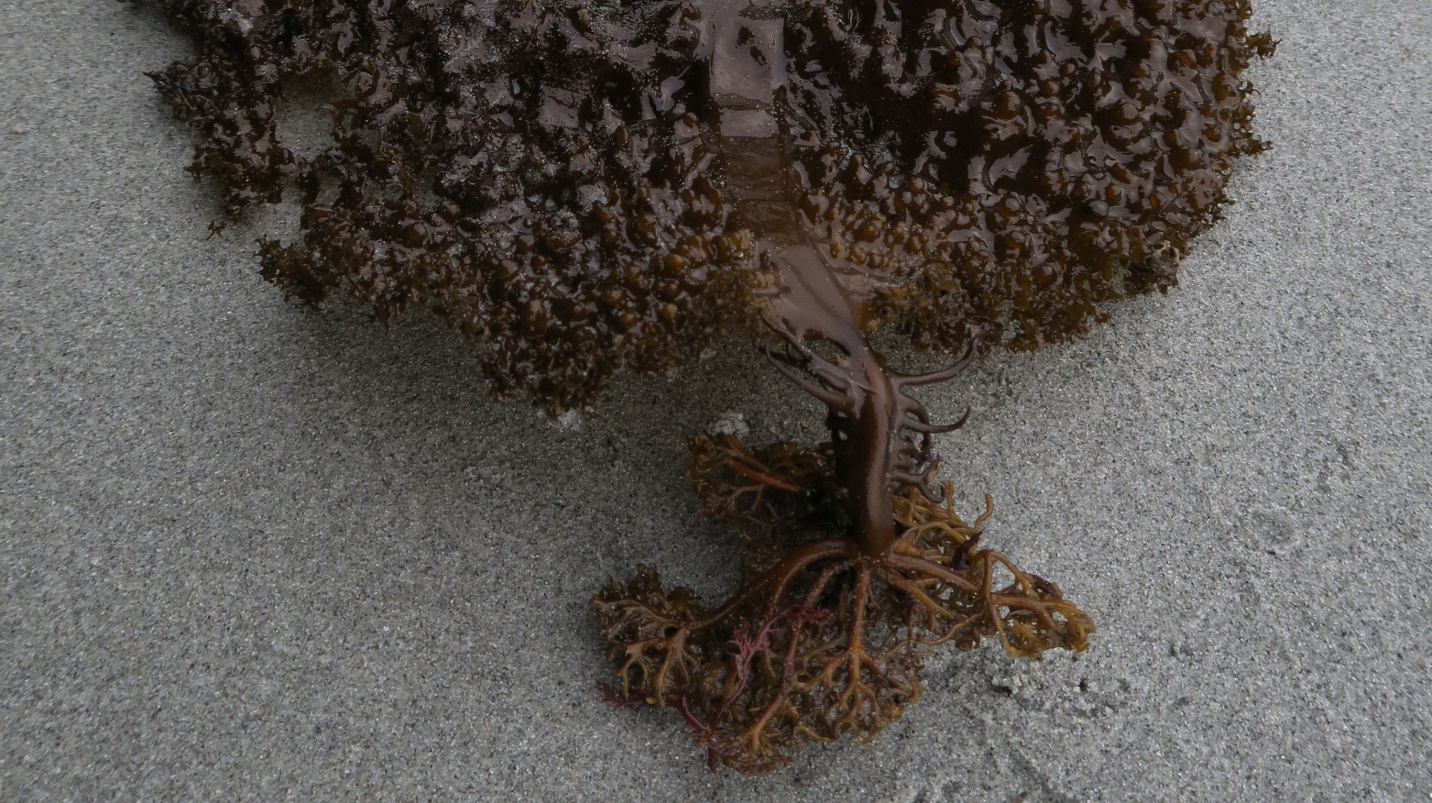
Figure 7: Neoagarum fimbriatum - the holdfast, flattened stipe with fimbriae and the broad multi-textured blade beyond. It seems common that when Neoagarum is dislodged from the substrate and washes ashore, it does not do so as parts broken off but with the whole thallus, holdfast to tip of blade, entire such as is seen in this photo. Gonzales Bay, Juan de Fuca Strait, BC, Canada. January 4, 2021. Photo ID 27179 ©Seaweedwhisperings.com
Biology & Natural History Information:
Description: Thallus is a single, elliptical and bullate blade that grows from a somewhat flattened stipe to lengths easily 80cm and often 1 meter or longer. The blade can be very puckered-looking and numerous, irregular holes are scattered throughout. A distinct midrib (approximately 1-3cm wide) arises as a continuation of the stipe. There are numerous branched fimbriae that grow along the flattened margins of the stipe. The hold fast is composed of numerous branched haptera.
Habitat:
On rocks, wood or other algae; usually found in the subtidal zone to 20 meters (and deeper) depth in semi-protected to semi-exposed habitats. It tends to avoid wave exposure and will extend into shallower intertidal areas in sheltered sites.
North Pacific Distribution:
Southeast Alaska to Baja California, Mexico.
Remarks:
Differentiated from a very similar species, Agarum clathratum, by the bullate blade, flattened stipe, and numerous fimbriae along margin of stipe.
Former name(s):
Agarum fimbriatum Harvey
Origin of Species Name:
Adjective (Latin), fringed.
Phylum: Ochrophyta
Class: Phaeophyceae
Order: Laminariales
Family: Agaraceae
Genus: Neoagarum
Species: Neoagarum fimbriatum (Harvey) H.Kawai & T.Hanyuda 2017
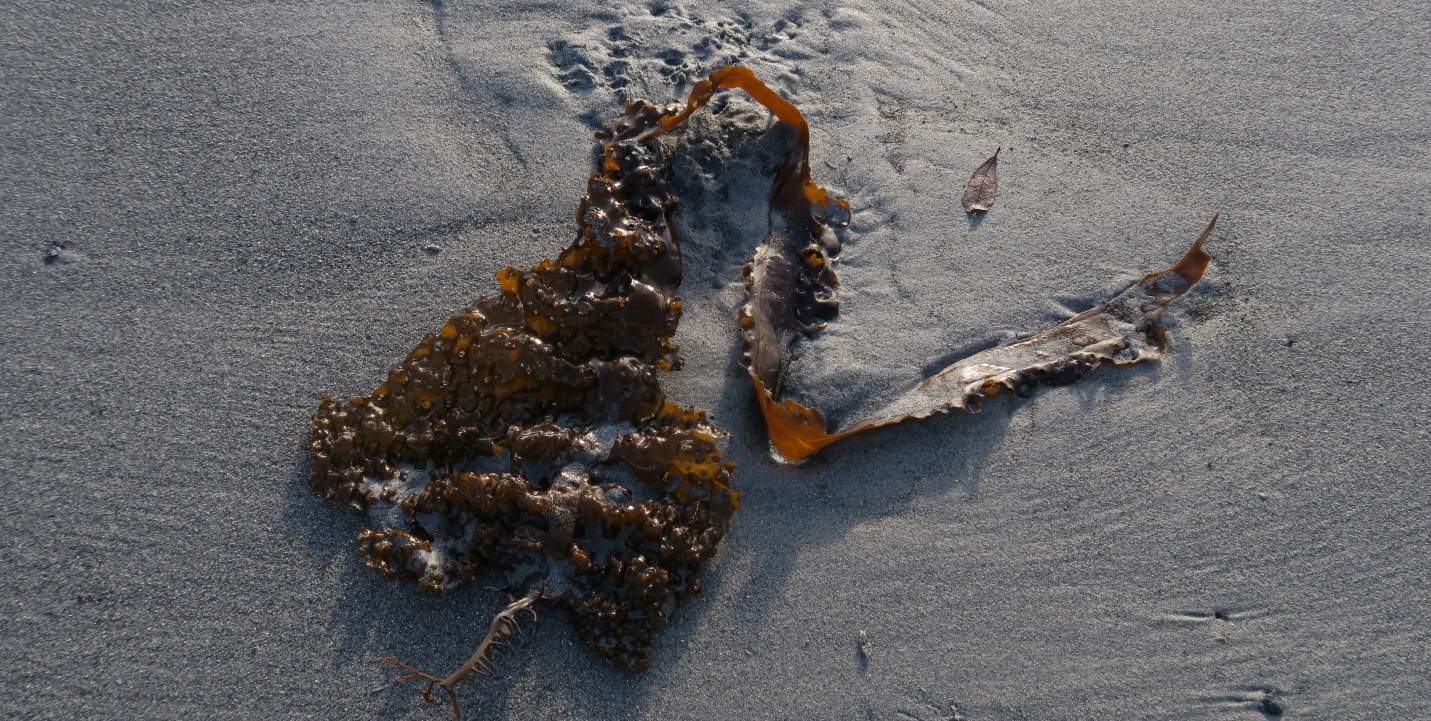
Figure 8: Dislodged from the subtidal substrate and washed ashore by winter storms, this Neoagarum fimbriatum specimen has a long part of the midrib ‘strap’ that is left with only tatters remaining of the blade on each side; Gonzales Bay, Juan de Fuca Strait, BC, Canada. February 7, 2021. Photo ID 27180 ©Seaweedwhisperings.com
![]()